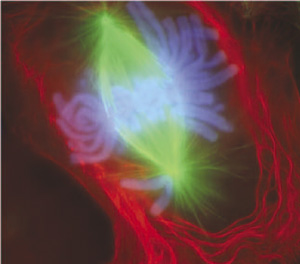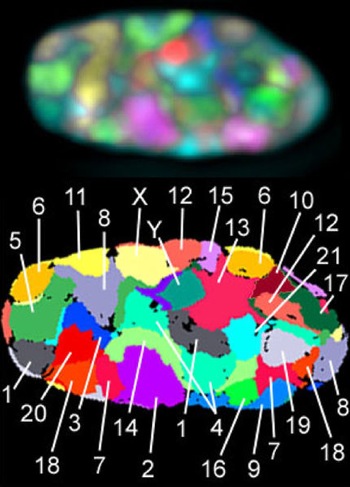
Cell Nucleus
last authored: April 2010, Jessie Kang
last reviewed:
Introduction
The nucleus is the control centre of the cell, and contains the genetic material that is organized in chromosomes. This compartment of the cell is responsible for the expression of the genes contained in the chromosomes, as well, it is the major site for cell reproduction and growth.

mitosis courtesy of
The nucleus is a cell organelle that consists of a double membrane also known as the nuclear envelope. This structure is one of the fundamental ways of differentiating between eukaryotic cells (eu = true, karyon = nucleus) and prokaryotic cells (pro = before, karyon= nucleus).
Structures of the Nucleus
Nuclear envelope and pores
The nucleus is characterized by the presence of the double membrane known as the nuclear envelope, which consists of an inner and an outer membrane. The area between the inner and the outer membrane is known as the perinuclear space. The outer membrane is continuous with the rough endoplasmic reticulum and the perinuclear space is connected to the lumen of the rough endoplasmic reticulum.
The nuclear membranes are lipid bilayers, which serve as physical barriers to control the entry and the exit of various cellular factors. On the nuclear envelope, structures called nuclear pores are present. These complexes allow the translocation of proteins needed for transcription and chromosome replication into the nucleus, while the rRNA and mRNA, as well as tRNA are allowed to depart the nucleus for protein synthesis in the cytosol. A nuclear localization signal is needed for the transport for proteins from the cytoplasm to the nucleus, while a nuclear export signal is needed for the transport of proteins from the nucleus to the cytosol.
Nuclear lamina
The inner membrane of the nucleus is connected to the nuclear lamina, which is a network of proteins (more specifically, intermediate filaments). These structures are involved with forming and destroying the nuclear membrane under certain cellular conditions. The nuclear lamina provides structural support for the nucleus, as well, serves as a site for chromosomal attachment. It therefore has a crucial role in DNA replication and cell division.
Chromosomes
Chromosomes are structures that are composed of linear DNA molecules, which contain the genetic information of the cell, and proteins such as histones, which help to package the DNA.

human chromatin;
courtesy of Bolzer et al, 2005 PLoS Biology
In eukaryotic cells, chromosomes are usually found in a condensed form called the chromatin. There are two types of chromatin: heterochromatin, which is known as the ‘silent DNA’ that does not actively transcribe, and the euchromatin, which is known as the ‘active DNA’.
The shape of the chromosomes differs based on the phase of the cell cycle. After duplication of the chromosomes, such as during metaphase, the chromosome consists of two linear molecules (two sister chromatids) that is joined at the centromere. However, during interphase, the chromosome remains in an unduplicated form (single linear strand of DNA).
Chromosomes play an essential part in cellular replication and division. These must be copied, and divided and passed onto daughter cells, which will have identical copies of the genes as the parent cell.
Nucleolus
The nucleolus is a prominent region within the nucleus that is not membrane bound. It is the site of rRNA synthesis, where the rRNA is transcribed and assembled. The nucleolus is also the site of ribosome assembly, where the 40S and the 60S ribosomal subunits are transcribed.
Functions of the Nucleus
Gene expression
see main topic: gene transcription
The nucleus contains genes for proteins that carry out different cellular functions. These genes are first transcribed, where DNA is read by RNA polymerase to produce messenger RNA (mRNA). This mRNA must exit the nucleus via nuclear pores as ribosome machinery to translate the mRNA into protein in the cytoplasm.
Processing of pre-mRNA
Pre-mRNA is the mRNA is transcribed from the DNA by the RNA polymerase. Before pre-mRNA can be exported to the cytoplasm to exist as mature mRNA, post transcriptional modification must occur in the nucleus for eukaryotic cells. Such modifications include the capping of the 5’ end of the pre-mRNA, poly-adenylation of the 3’ end of the pre-mRNA, and RNA splicing. Without these modifications, the pre-mRNA is quickly degraded in the nucleus. These modifications are not necessary in prokaryotic cells.
The addition of the cap involves the addition of a nucleotide on the 5’ end of the pre-mRNA for stability of the mature mRNA for translation in the cytoplasm.
The addition of a poly(A) tail, which is a long stretch of RNA with only adenine bases, to the 3’ end of the pre-mRNA is crucial for the nuclear export, translation and stability of the mature mRNA. The tail can be shortened over time, and when it gets to a certain length, the mRNA is degraded.
RNA splicing is carried out by an enzyme complex known as the spliceosome. Splicing is when regions in the pre-mRNA called introns, which do not encode for genes, are removed and the remaining gene-coding regions called extrons, are ligated back together to form one continuous molecule.
Nuclear transport
The entry and the exit of molecules from the nucleus are very tightly regulated. Very small molecules can generally diffuse in and out of the nucleus through nuclear pores and the plasma membrane, however, larger molecules such as RNA and proteins require the help of additional proteins such as importins and exportins to enter and exit the nucleus, respectively. The nuclear localization signal on proteins to enter the nucleus is bound by importins, while those proteins with the nuclear export signal to leave the nucleus is bound by exportins. The ability of importins and exportins to release their cargo in the correct cellular compartment is regulated by GTPases, which are enzymes that hydrolyze guanosine triphosphate (GTP), a cellular energy molecule, to release energy.
Assembly and disassembly
The nucleus is not a static organelle. During its lifetime, it may be broken down in a process such as apoptosis, which is also known as programmed cell death, or during cell division. Both of these events include degradation of the nuclear envelope and lamina. During cell division, mitosis, one cell gives rise to two daughter cells that are identical. In order for this to occur, the nucleus must ‘split in half’, as the replicated chromosome in the nucleus must equally be pulled to two opposite poles. Therefore, in the early stages of the cell cycle, both the nuclear envelope and the lamina are dismantled. In the process of apoptosis, the cell is systematically destroyed and disintegration of the nuclear lamina and envelope plays a crucial role in changes associated with programmed cell death.
Cell compartmentalization
Some organelles in the cell are surrounded by a membrane, which separate the internal cellular proteins of that specific organelle with the rest of the cell. Each compartment consists of its own specific enzymes and molecules, for example, the enzyme glutamate dehydrogenase, are found in the mitochondria exclusively.
The nucleus consists of a double membrane, and has nuclear pores which regulate the entry and exit of cellular factors. Cell compartmentalization plays a role in regulating translation, as the cell is prevented from translating unspliced mRNA. The pre-mRNA that is transcribed must first be spliced in the nucleus and be transported out through the nuclear pores to be translated by ribosomes. Translation of the unspliced mRNA (if there were no nuclear compartmentalization), would result in non-functional proteins.
Resources and References
